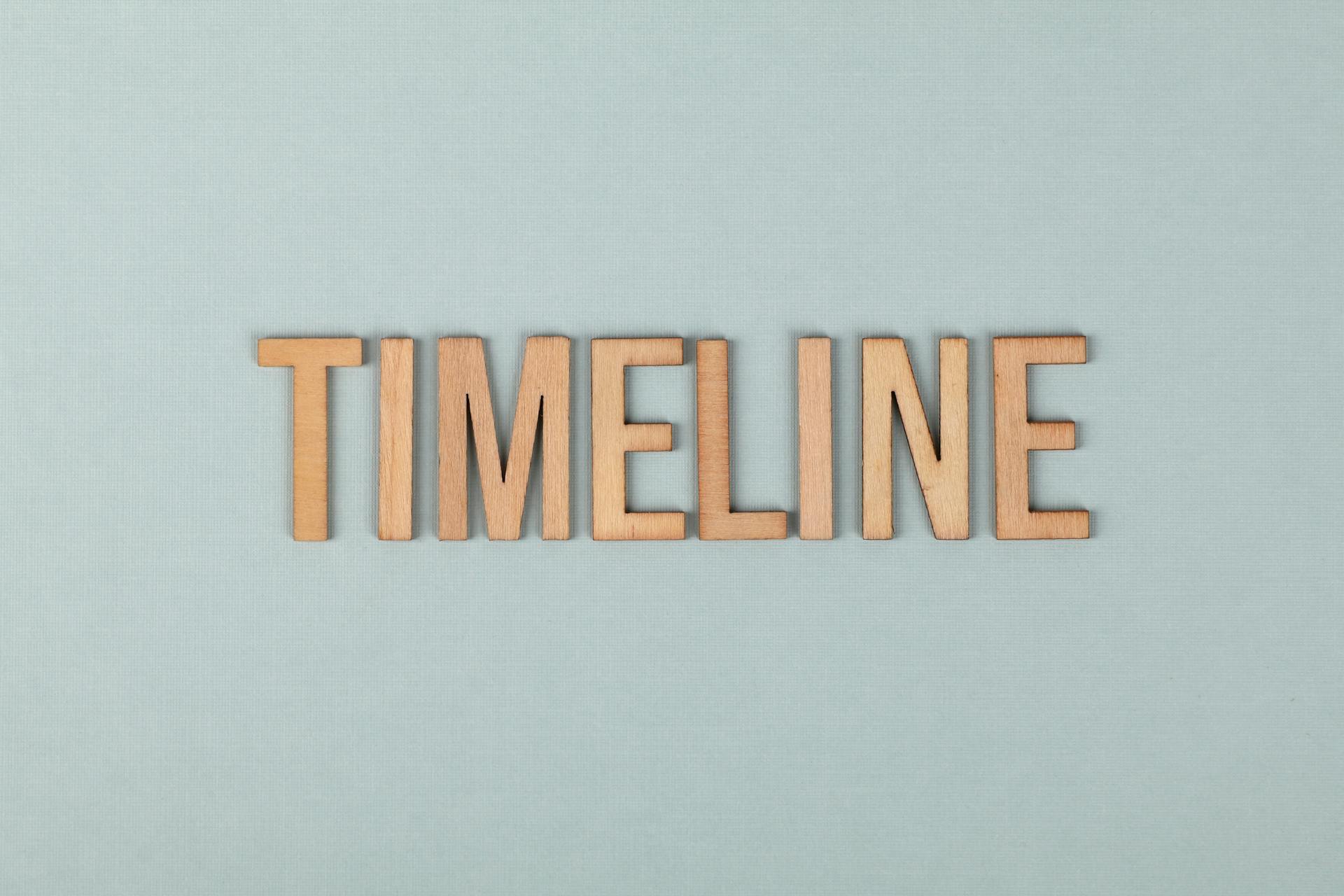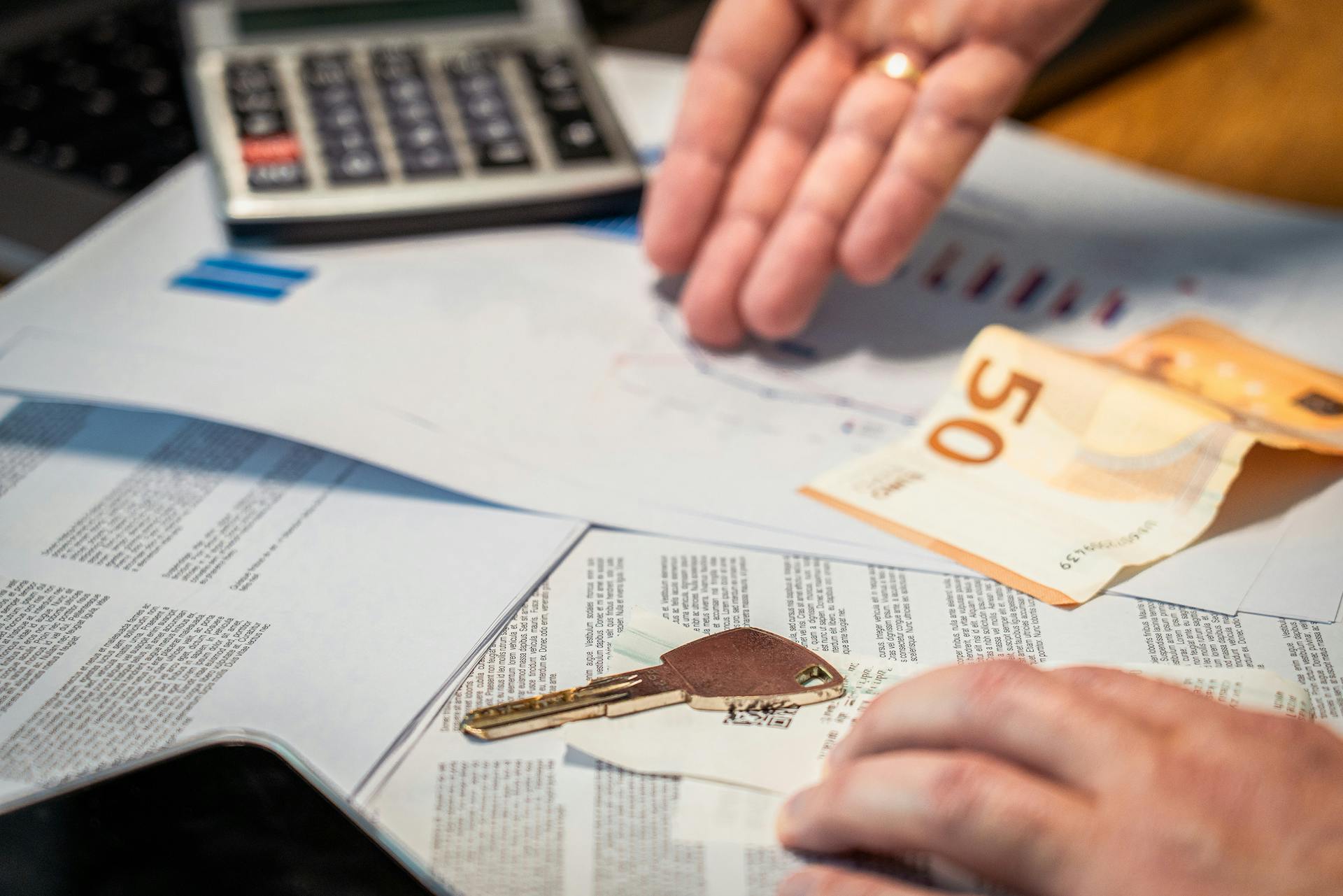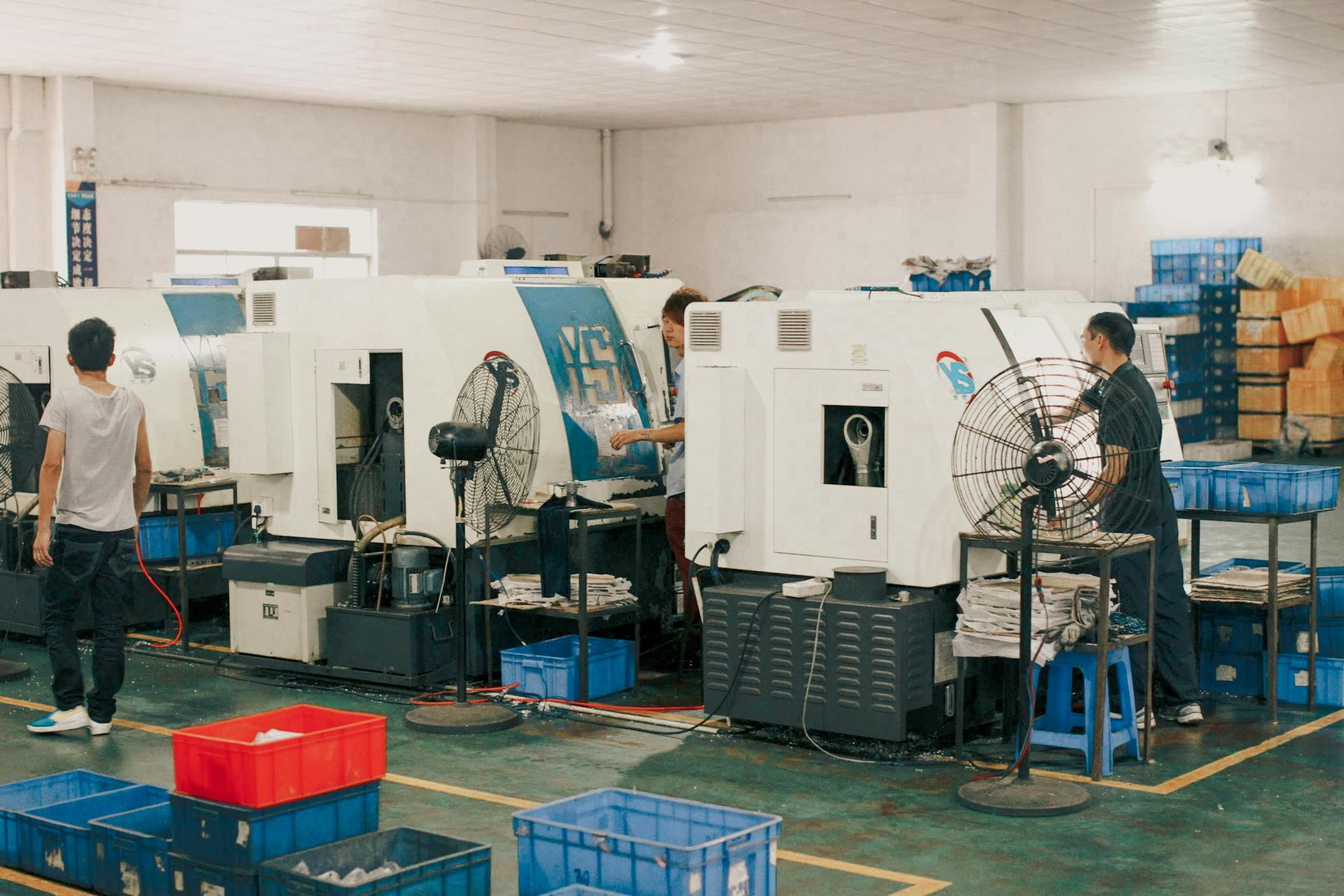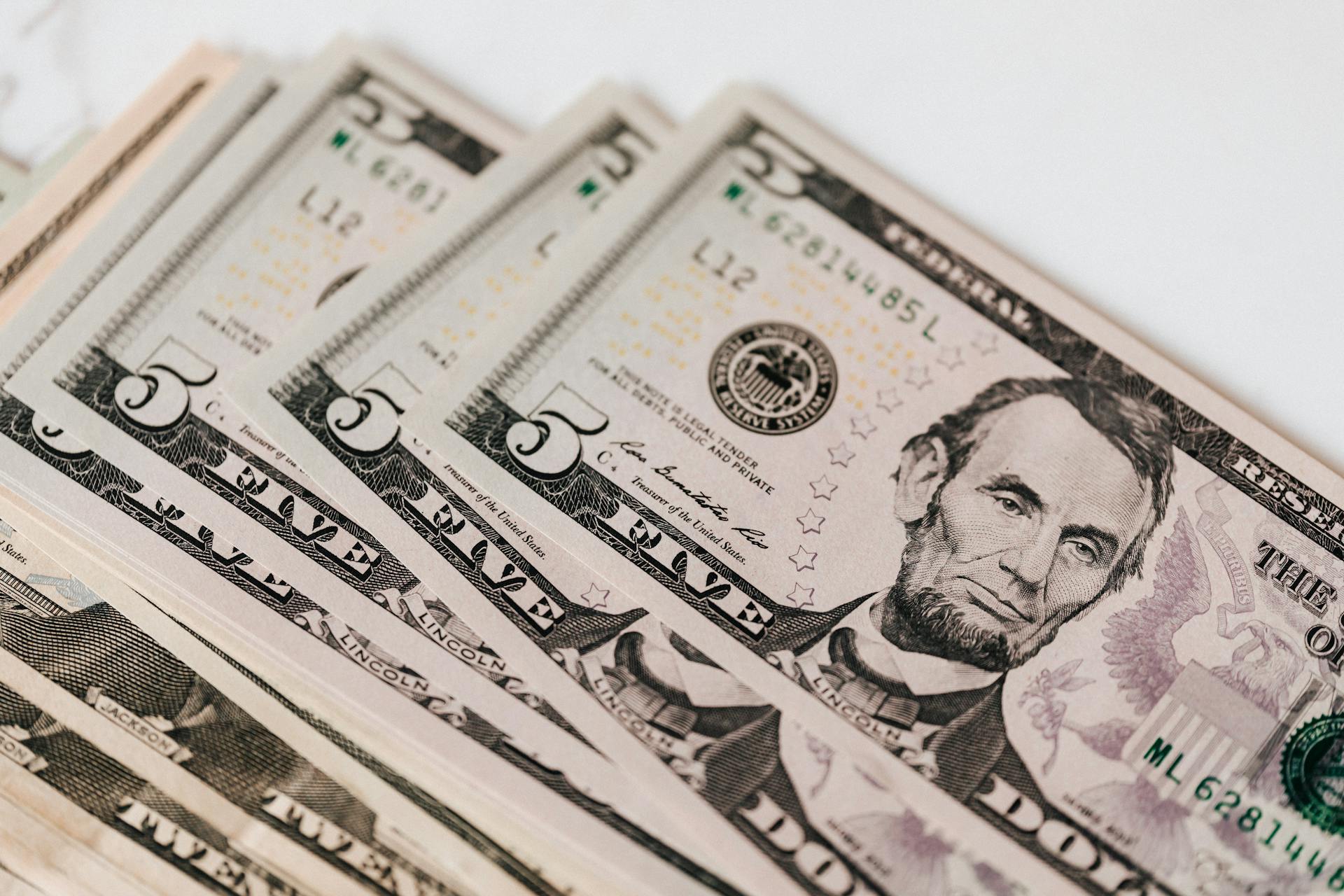
You start depreciating assets when they are placed in service, not when you purchase them. This is a key distinction, as it allows you to begin depreciating the asset as soon as it's ready to use, rather than waiting until it's actually in use.
The IRS defines "placed in service" as the date when an asset is ready to be used for its intended purpose, which can be different from the date of purchase. For example, if you buy a piece of equipment but it takes several months to be installed and commissioned, you can still depreciate it as soon as it's installed.
In general, you can depreciate assets that have a useful life of more than one year. This includes things like buildings, equipment, and vehicles, but not things like inventory or land.
Expand your knowledge: Why Land Not Depreciated
What Is Asset Depreciation?
Anything you own with a dollar value tied to it is an asset. A tangible asset is anything of value you can touch.
A fixed asset is a type of tangible asset that would take time to liquidate, such as office furniture or a company vehicle. Inventory items aren't considered fixed assets as they are quick to sell.
The IRS lets you claim less income when buying expensive fixed assets for business use. This is where depreciation comes in.
Depreciation is the process of spreading the cost of a fixed asset over its useful life. You can calculate the depreciation rate using the formula: DEPRECIATION RATE = PURCHASE PRICE / DEPRECIATION AMOUNT.
Depreciation Methods
There are several common methods for depreciating an asset, including straight-line, double-declining balance, units of production, and sum-of-the-years' digits.
Straight-line depreciation is a simple method that depreciates an asset by a fixed amount each year. The formula for straight-line depreciation is Depreciation Rate = Purchase Price / Depreciation Amount. This method is often used for accounting purposes.
The double-declining balance method is an accelerated method that depreciates an asset more quickly in the early years. This method front-loads a large portion of the expense in the first year, making it a good choice for startups and businesses with a lot of bills.
See what others are reading: Straight Line Depreciation Chart
Here are the four main types of depreciation methods:
The units of production method is a good choice for assets that operate extensively over a period of time, such as equipment, vehicles, and machines. This method uses the formula [(Original value – salvage value) / estimated production capability] x units per accounting period = units of production depreciation.
Threshold Amounts
Threshold amounts can vary greatly between companies, with some setting a $500 threshold and others a $10,000 threshold.
A company with a $500 threshold will depreciate assets purchased for $500 or more, while expensing assets under $500 in the year they're purchased. This means that small purchases may not be worth depreciating.
You might be thinking, "What about the purchase price of my office furniture?" Well, if it costs $500 or more, it's considered a fixed asset and will be depreciated over time.
The IRS allows companies to set their own threshold amounts, giving them flexibility in how they account for their assets.
Readers also liked: What Are Asset Management Companies
Production Method
The units of production method is a great way to depreciate assets that operate extensively over time, like equipment, vehicles, and machines. This method determines the value of a company's income-producing assets before they deteriorate.
This method uses a formula to calculate depreciation: [(Original value – salvage value) / estimated production capability] x units per accounting period = units of production depreciation.
Tax Implications
Businesses can use depreciation to reduce their tax liability, but the IRS has requirements for the types of assets that qualify. Under U.S. tax law, a business can take a deduction for the cost of an asset, but the cost must be spread out over time.
The IRS lets you claim less income when buying expensive fixed assets for business use. This is especially helpful for startups and businesses with a lot of bills.
You can use the straight-line method or the double-declining method for tax purposes, but the double-declining method front-loads a large portion of the expense in the first year, allowing businesses to recoup some of their costs sooner.
Explore further: What Are Deferred Tax Assets
Taxes and Depreciation
Businesses use depreciation to reduce their taxable income and lower their tax liability. This is done by taking a deduction for the cost of an asset, which must be spread out over time in most cases.
Depreciation is allowed for buildings and structures, but not for land. This means that if you own a commercial building, you can depreciate it over time, but the land it sits on is not eligible for depreciation.
A fixed asset is a tangible asset that takes time to liquidate, such as office furniture or a company vehicle. These types of assets can be depreciated, and the IRS allows you to claim less income when buying them for business use.
The IRS uses a formula to calculate depreciation: Depreciation Rate = Purchase Price / Depreciation Amount. This helps determine how much of the asset's value can be claimed as a deduction each year.
Section 179 is an immediate expense deduction, similar to bonus depreciation, but with some key differences. It allows taxpayers to deduct a set dollar amount, rather than a percentage, making it a valuable option for businesses that need to quickly expense large assets.
Additional reading: Journal Entry for Disposal of Asset Not Fully Depreciated
Tax Methods
Tax Methods can be overwhelming, but they don't have to be.
The IRS allows businesses to use several common methods for depreciation, including straight-line, double-declining balance, units of production, and sum-of-the-years’ digits.
Straight-line depreciation is a good choice for accounting purposes, but it's not the best for taxes. Double-declining and sum-of-the-years digits methods are better suited for taxes because they allow businesses to recoup some of their costs sooner.
Businesses can also use the straight-line method for tax purposes, but it's not as effective as double-declining or sum-of-the-years digits. The straight-line method simply divides the cost of an asset by its useful life.
The sum-of-the-years digits method is more complex, but it's a good choice for businesses with a lot of assets to depreciate. This method uses a formula to calculate the depreciation of an asset, with the goal of maximizing the amount of depreciation written off in the first year.
What Is a Schedule?

A depreciation schedule is a crucial tool for businesses to calculate the value of their assets over time. It's used to determine the depreciation expense, which affects the income statement and balance sheet.
The schedule typically includes information such as the asset's description, date of purchase, cost, expected life, and method of depreciation. This information is used to calculate the depreciation expense, which is then used to determine the net book value of the asset.
A depreciation schedule can be used to calculate depreciation expense using either the straight-line method or the accelerated method. The straight-line method subtracts the salvage value of an asset from the initial cost and divides the result by the estimated number of useful years. This means that the business expenses an equal amount of depreciation for each year.
The accelerated method, on the other hand, writes off depreciation costs more quickly to minimize taxable income. This method is often used by businesses that want to reduce their taxable income.

Here are the key components of a depreciation schedule:
- Description of asset
- Date of purchase
- Cost
- Expected life
- Method of depreciation
- Salvage value
- Current year depreciation
- Cumulative depreciation
- Net book value = Cost – Cumulative Depreciation
By using a depreciation schedule, businesses can accurately calculate their depreciation expense and make informed decisions about their assets. This is especially important for financial modeling, where a depreciation schedule is required to forecast the value of a company's fixed assets, depreciation expense, and capital expenditures.
Calculating Depreciation
You'll need to calculate the depreciation of your asset to determine its value over time. The Depreciation Rate is calculated by dividing the Purchase Price by the Depreciation Amount.
The Depreciation Rate is a percentage amount a fixed asset depreciates each year. You can use the straight-line method or the double-declining method to calculate depreciation, depending on your needs. The double-declining method front-loads a large portion of the expense in the first year.
To calculate the Depreciation Amount, you'll need to know the Purchase Price and the Salvage Value of the asset. The Salvage Value is the dollar amount you expect to receive when selling a fixed asset at the end of its useful life. Some assets aren't worth anything once depleted and have a $0 salvage value.
Worth a look: How Much Did Bitcoins Cost Originally
Determining Salvage Value

Determining Salvage Value is a crucial step in calculating depreciation, and it's not as straightforward as you might think.
Salvage value can be based on past history of similar assets.
A professional appraisal can also be used to determine salvage value, giving you a more accurate estimate.
The IRS publishes depreciation schedules indicating the total number of years an asset can be depreciated, which can influence salvage value.
Salvage value is the carrying value that remains on the balance sheet after all depreciation is accounted for, so it's essential to get it right.
A percentage estimate of the value of the asset at the end of its useful life can also be used to determine salvage value.
Use Dedicated Software
Storing your depreciation value in a dedicated software can be a game-changer for tracking your assets. Asset Panda is a great option that allows you to store depreciation value in each individual asset record.
Having this information easily accessible will help you compare your estimated depreciation value to the actual value. This can be a valuable tool for spotting any discrepancies or issues with your assets.
You can use dedicated software to store estimated depreciation values and compare them to actual values, giving you a clear picture of your assets' performance.
You might like: Is Software Amortized or Depreciated
Asset Depreciation Methods

Asset depreciation is a crucial concept for businesses and individuals alike. It's the process of reducing the value of an asset over time, which can be done using various methods.
Straight-line depreciation is a common method that calculates depreciation as a fixed rate each year. This method is suitable for assets with a predictable usage pattern, such as office furniture. The formula is simple: (Asset Price - Salvage Value) / Useful Life.
There are also accelerated depreciation methods, like double-declining balance, which front-load a large portion of the expense in the first year. This method is better suited for taxes and can be beneficial for startups and businesses with a lot of bills. The double-declining balance method uses an asset's straight-line depreciation rate and first-of-the-year book value.
Other methods include units of production, which is suitable for income-producing assets that deteriorate over time. The formula is: [(Original Value – Salvage Value) / Estimated Production Capability] x Units per Accounting Period = Units of Production Depreciation.
Here are some common asset depreciation methods:
- Straight-line depreciation
- Double-declining balance
- Units of production
- Sum-of-the-years digits
Each method has its own formula and application, and the choice of method depends on the specific asset and business needs.
Asset Depreciation Methods

Depreciation can be a complex process, but it's essential to understand the basics. The IRS lets you claim less income when buying expensive fixed assets for business use.
To depreciate assets, you need to know which ones to depreciate. Trying to depreciate all of your assets may not be the smartest decision.
Fixed assets, such as office furniture, a warehouse, or a company vehicle, are good candidates for depreciation. Examples include office furniture, a warehouse, or company vehicle.
The IRS has specific depreciation guidelines, and it's essential to follow them. Real estate or property has a depreciation life cycle of 27.5 years.
Non-property fixed assets like vehicles and computers have a life cycle of 5 years. If you have any assets with a shorter lifespan, it may not be worth depreciating them.
To calculate depreciation, you can use the formula DEPRECIATION RATE = PURCHASE PRICE / DEPRECIATION AMOUNT. This will give you a clear understanding of how much you can depreciate each year.
For another approach, see: Tequila Company
Straight-Line Method

The straight-line method is a simple and commonly used depreciation method. It's calculated by dividing an asset's cost evenly over each year of its useful life until the value equals its salvage cost.
To use straight-line depreciation, you need to know the asset's price, salvage value, and useful life. This method shows a balanced drop in value for assets without a set usage pattern.
The equation for straight-line depreciation is: STRAIGHT-LINE DEPRECIATION = ASSET PRICE - SALVAGE VALUE / USEFUL LIFE. For example, if you buy a new office printer for $22,000 and want to depreciate its value, with a salvage value of $2,000 and a useful life of 5 years, the depreciation for the printer will be $4,000 per year.
This method is always a fixed rate, making it easy to calculate and understand.
Double Declining Balance Method
The Double Declining Balance method is an accelerated depreciation method that's perfect for businesses with high upfront costs. This method is also known as the DDB method.

The DDB method doubles the straight-line depreciation rate, making it twice as fast as the declining balance method. For example, if a machine costs $5,000 and has a useful life of five years, the depreciation in year one would be $5,000 x (2 / 5), or $2,000.
To calculate the DDB depreciation, you can use the formula: DOUBLE-DECLINING DEPRECIATION = 2 * STRAIGHT-LINE DEPRECIATION RATE * FIRST-OF-THE-YEAR BOOK VALUE. This formula helps you determine the depreciation expense for each year.
The DDB method is ideal for businesses that want to recognize more expense in the early years of an asset's useful life. It's also suitable for assets that depreciate faster in the early years. For instance, a printer with five years of useful life might depreciate more quickly in the first year, making the DDB method a good choice.
Here's a comparison of the straight-line and DDB methods:
As you can see, the DDB method accelerates the depreciation expense in the early years, making it a great option for businesses with high upfront costs.
Frequently Asked Questions
Do you depreciate assets in the first year?
Depreciation in the first year is prorated based on the asset's service period. The actual depreciation amount is distributed over the number of months the asset is in service during the first year.
Sources
- https://www.investopedia.com/terms/d/depreciation.asp
- https://www.botkeeper.com/depreciation-schedule
- https://tax.thomsonreuters.com/blog/tax-depreciation-101/
- https://corporatefinanceinstitute.com/resources/financial-modeling/depreciation-schedule/
- https://www.assetpanda.com/resource-center/blog/guide-to-depreciate-fixed-assets/
Featured Images: pexels.com


